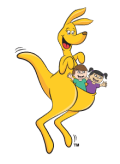Dr Robyn Floyd
The multi-sensory experiences at GymbaROO-KindyROO are perfect for ‘STEM ready’ children. This century is all about innovation and Dr Robyn Floyd has some great ideas for supporting STEM development.
Children begin life ‘STEM-ready’.
Think about it: children are curious and constantly ask questions. They keenly observe the world around them and are good at connecting ideas. They sketch and draw a lot. They astutely observe others’ behaviours. Children like to build models, break them down, and then begin again. They like to experiment and try new things. In a nutshell, children are great natural learners — just the kind of learners we need for successful STEM work (or any work, for that matter). Anne Jolly (2012)
How can parents nurture early science, technology, engineering and math (STEM) skills? We know that children are naturally curious and that children learn through play. STEM for toddlers and preschoolers, is also about providing multi-sensory experiences in science, technology, engineering and mathematics. Sensory input from seeing, hearing, tasting, touching and smelling are all important parts of meaningful learning experiences. Lilian G. Katz (2010) suggests that best practice for early education is to encourage children to ‘be active, engaged, and take initiative in their own learning’.
So how can you encourage an interest in these fields with your child? You don’t need to be a scientist or engineer! Here are a few ideas that might suggest some ways to help your child become a STEM–thinker.
Observing scientifically
Using STEM language in every day life by labelling attributes helps children to develop critical thinking and learn to make scientific observations. Include words like big, small, tiny, heavy, light, round and cylindrical in your conversations to encourage comparison of size, colour, texture, smell, taste, sound or weight of objects.
- When walking by a creek ask questions that explore comparison.
Can you find a smooth rock and one with sharp edges? What do you think will happen when you drop a small rock or large rock into the water? Try it.
- Build on your child’s interests and pique their curiosity. How many wheels does the fire truck have? Or the car? What is different about the wheels on a train and a car? Which toy vehicle is bigger? Is the car faster on carpet or floorboards?
- Make mealtimes a STEM lesson by cutting portions into halves or quarters or lifting different fruits to see which is heavier or lighter.
Embrace curiosity and the endless ‘why’ questions
Does your child continually ask “why”? At times the questions can seem relentless but this is actually a STEM mindset and assists brain development. Research suggests that between the ages of one and four the brain is receptive to learning maths and logic. Every time your child asks a question a neuro pathway in their brain is forming. Take time to explain the things you understand, brush up what you don’t or find out together.
Change the ‘why’ questions to ‘what’ or ‘how’ questions
Encourage children to include ‘what’ and ‘how’ questions in their repertoire. The Boston Children’s Museum’s STEM Sprouts Teaching Guide (2016) recommends this as a simple strategy that allows children to observe, communicate, and predict rather than simply seeking the correct answer. Try to ask questions that encourage investigation such as:
What does it look like?
How does it feel?
What do you wonder about?
What else could you try?
Watch ‘docos’ together
Whether it’s TV, Netflix or You-tube there are plenty of educational programs related to STEM fields that are fun, and educational. Talk about the program you view. It might generate more why, what and how questions and encourage an interest in new areas.
Holiday STEM adventures
Talk about fractions when you order a pizza, or about gravity when a toy falls off a shelf. Visit Scienceworks, the zoo or museums. Alternatively visit their websites as many have additional resources, activities and ideas to inspire interest in STEM. Look for school holiday programs with a STEM approach.
STEM Projects
At primary school STEM is embedded in inquiry projects. These projects enable teachers to combine and integrate a variety of materials and experiences into what children might be interested in investigating. You can do this at home.
Could you set up a STEM station with materials for experimenting? Materials might include things like glue, straws or paper plates, crayons, paints, paper, scissors, markers, dough, cardboard, blocks, etc. There are many STEM websites that offer ideas. Make a marble/car run from cardboard rolls or sort the shells collected at the beach into size or shape.
STEM education supports children to learn necessary skills for our tech-savvy world. While children can visit hands-on museum displays or engage in the natural trial and error of play, just exploring their own backyard with a magnifying glass in hand builds STEM thinking. Research in neuroscience indicates that the basic architecture of a child’s brain is constructed through an ongoing process that begins before birth and continues throughout life. Whether children are observing, predicting, building, problem solving or measuring early critical thinking and reasoning skills will be developed, and may enhance later interest in STEM study and careers.
Dr Robyn Floyd (PhD, MEd, Spec. Cert. Leadership in Assessment): Assistant Principal – Specialist Curriculum Writer
References:
Katz, L. (2010), STEM in the Early Years, Seed Paper, University of Illinois at Urbana-Champaign
Jolly, A. (2012), 10 STEM Tips for Parents, MiddleWeb
www.middleweb.com/3569/10-stem-tips-for-parents/ accessed Nov 1, 2016
The Boston Children’s Museum’s STEM Sprouts Teaching Guide, accessed
www.bostonchildrensmuseum.org/sites/default/files/pdfs/STEMGuide.pdf November 1, 2016

